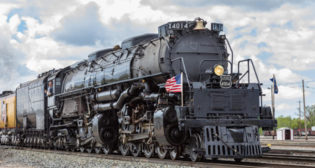
Choosing Locomotive Lighting For the Long Run
Written by John Fogel
VIA Rail photo
As transportation costs continue to rise, railways remain one of the most cost-effective ways to move people and products. Engineering hubs are the heart of keeping locomotives safe and getting them back on the rails as soon as possible. There are many components that work together for railway safety; one critical area is locomotive lighting.
New locomotives are built with LED lighting, both on the exterior and interior, providing a brighter longer lasting, albeit a more expensive alternative. For existing locomotive fleets, most likely it’s time to upgrade from incandescent lighting to a brighter future with a durable alternative. Both LED and halogen are offering alternatives with safety and maintenance benefits for Class I, passenger and light rail locomotives.
The biggest mistake made in transportation maintenance and repair today is making purchasing decisions based on the lowest price. Price should never be the only consideration even with something as simple as a lamp. For example, a $15 bulb may seem like a small part of a locomotive’s overall expense, but it can have a big impact when it goes out.
In addition to replacing the lamp itself, there is the labor involved in changing the lamp as well as the lost revenue while being serviced. For locomotive head lamps and ditch lamps, incandescent will always offer the lowest price, because they are the oldest technology and are not the most reliable or the most cost effective in the long run. These incandescent bulbs are less durable and continued vibration can cause the filament to break leaving the locomotive with only one light.
For head lamps, incandescent lamps also lose their aim from the constant movement on the track causing the beam to start to tilt up over time. Additionally, these lamps lack the brightness of the halogen and LED alternatives.
When we examine LED lighting options, cost tends to be the biggest concern. Current locomotives in production do come with standard LED lighting. This alternative does allow for brighter, longer lasting light. However, as these LED lights start to get older gradation is a factor. This is evident if you look, for example, at the simple LED strings of lights lining airplanes aisles. When the plane is new, the walkway lights are perfect. Within a few years, areas start to burn out and the lights start dimming. The only way to repair a light is to replace the whole line if LED lights on both sides of the aisle match.
Though LED is now considered the standard in most new locomotives, the lights can be upwards of $800, making it difficult to carry a stock of these high-ticket items at maintenance hubs. Shop managers must consider the cost and the benefit of having inventory sitting on the floor. In considering upgrading large Class I fleets, companies would spend in the millions of dollars, making the return on investment difficult to justify.
Hence, halogen becomes an excellent alternative to exterior incandescent and LED lighting. It is bright and durable. It holds its brightness until it burns out. These lights cost a fraction of LED, making it an easier part to carry, as well as to slowly convert locomotive fleets as new bulbs are needed. Halogen lamps, with the lower price point, make a return on investment a reality in addition to the benefit of improving safety on the rails with the brighter, more consistent lighting. Additionally, halogen lamps are great for colder climates as they heat up and melt ice and snow off the lamp.
So where else do LED and halogen lights fit in the locomotive safety equation? One of the best places to use LEDs is for lighting locomotive interiors, engine rooms, walkways and stairways. Here, these small lights – available for A19 sockets found on most locomotives – shine bright and make it simple for the crew and maintenance personnel to see, avoiding costly accidents. These bulbs, while they do dim slowly over time, still last very long, are easily available, and are easy to replace (being that they are “classic” A-series bulbs used in households).
In summation, lighting choices, while a small piece of the overall locomotive maintenance, are an area worth reviewing for cost and time savings. Replacing incandescent head lamps with halogen or LED means less staff in harnesses changing bulbs, more uptime and brighter, safer rails.

John Fogel, Halogen Product Manager at Amglo, has worked with the company for 15 years in product development.



